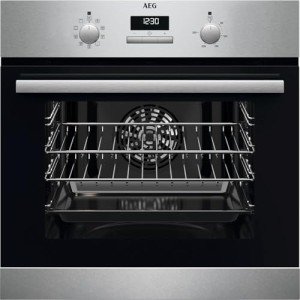
Single Oven And Hob
Add a review FollowOverview
-
Founded Date August 18, 1942
-
Sectors Charity & Voluntary
-
Posted Jobs 0
-
Viewed 4
Company Description
This Is The Ultimate Guide To Single Fan Oven
Understanding the Single Fan Oven: A Comprehensive Guide
The culinary world has actually developed considerably throughout the years, with home appliances ending up being more sophisticated and efficient. One such advancement is the single fan oven, a kitchen staple for many home cooks and professional chefs alike. This article explores the complexities of single fan ovens, their advantages, and useful tips for usage.
What is a Single Fan Oven?
A single fan oven, likewise understood as a convection oven, is developed to prepare food evenly using a fan and an internal exhaust system. Unlike traditional ovens that rely mainly on convected heat, single fan ovens; Git.ezmuze.co.uk, distribute hot air around the food, guaranteeing a consistent temperature level throughout the cooking process. This feature boosts cooking effectiveness and reduces cooking times compared to standard ovens.
How Does a Single Fan Oven Work?
The mechanics of a single fan oven are uncomplicated however ingenious. The oven comprises numerous crucial components:
- Heating Element: This creates the heat required for cooking, usually located at the top and bottom of the oven.
- Fan: Positioned at the back of the oven, this element distributes the hot air around the food.
- Control board: It enables users to set the temperature level and cooking time.
- Thermostat: This device monitors and maintains the desired temperature level throughout cooking.
When the oven is turned on, the heating elements heat up, and the fan starts to distribute the heat equally. This ensures that all sides of the food are exposed to hot air, leading to better cooking results– particularly for baked items.
Benefits of Using a Single Fan Oven
Single fan ovens boast numerous benefits, making them popular amongst cooking lovers. The main advantages include:
1. Even Cooking
- The circulating air avoids cold and hot areas within the oven, permitting food to prepare evenly. This is especially useful for baking pastries, cakes, and bread.
2. Minimized Cooking Time
- By flowing hot air, stove generally cook food quicker than conventional ovens. This can result in time cost savings in meal preparation.
3. Energy Efficiency
- Single fan ovens generally use less energy, as they can cook food faster and might require lower temperature levels.
4. Browning and Crisping
- The air flow in a single fan oven helps attain a preferable golden-brown surface on meals, particularly casseroles, roasted vegetables, and meats.
5. Adaptability
- These ovens are capable of a variety of cooking designs, from roasting and baking to broiling and reheating leftovers.
Comparing Single Fan Ovens with Traditional Ovens
To better comprehend the special qualities of a single fan oven, it’s advantageous to compare it to a conventional oven. The table listed below sums up crucial differences:
| Feature | Single Fan Oven | Traditional Oven |
|---|---|---|
| Cooking Method | Convection (circulating air) | Radiant heat |
| Cooking Time | Much shorter | Longer |
| Temperature level Consistency | More consistent | Can have hot/cold spots |
| Energy Consumption | Generally lower | Greater |
| Suitable for Baking | Much better browning and increasing | Great for roasting |
How to Use a Single Fan Oven
For ideal outcomes with a single fan oven, think about these useful tips:
-
Adjust Temperature and Cooking Time:
- When using a single fan oven, lower the cooking temperature level by about 20 ° F (10 ° C) compared to conventional recipes. As a guideline of thumb, look for doneness a bit earlier than specified.
-
Usage Shallow Baking Pans:
- Shallow pans allow much better air flow, promoting even cooking and browning.
-
Prevent Crowding the Oven:
- Ensure appropriate area between meals for air circulation.
-
Turn Baking Sheets:

- For several trays or pans, rotate them midway through cooking to make sure even heat distribution.
-
Keep the Oven Door Closed:
- Each time the door is opened, heat gets away; avoid unnecessary openings throughout cooking.
Frequently Asked Questions About Single Fan Ovens
-
Can I utilize regular dishes in a single fan oven?
- Yes, but it’s recommended to adjust both the temperature and cooking time for optimal results.
-
Are single fan ovens more costly than traditional ovens?
- They can vary in price, but while some models might be more costly, their effectiveness can result in cost savings on energy costs.
-
Can I bake several items at when?
- Yes, but spaced out properly for even air flow. It’s a good idea to turn trays midway through cooking.
-
Do single fan ovens come with additional features?
- Lots of designs include self-cleaning options, several cooking modes, and clever innovation for boosted benefit.
-
Is upkeep different for single fan ovens?
- Upkeep is comparable but be conscious of the fan and ensure it’s kept clean for optimal efficiency.
The single fan oven stands apart as an exceptional option for those aiming to enhance their culinary abilities and efficiency in the kitchen. Its capability to prepare food equally and quicker can change the cooking experience, making the most complicated dishes basic to carry out. By understanding how to utilize a single fan oven effectively and leveraging its benefits, home cooks and expert chefs can enjoy a more enjoyable and efficient cooking journey.
